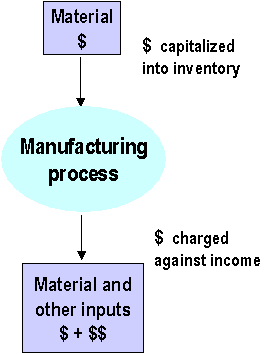COGS and Inventory
The cost of materials and other inputs of the production process are capitalized into inventory at the time of purchase or manufacture. At the time a product using those materials is sold, the inventory is written down by the cost of goods sold (COGS) and the expense is recognized in income.
In theory,
inventory costs should include all charges incurred in the purchase and
manufacture of a good, including cost of materials, logistics, direct
and indirect labor, and various indirect (i.e., allocated) manufacturing
costs such as supplies, depreciation, and utilities.

As a practical matter, many indirect costs are difficult to trace to particular goods and, therefore, are expensed in the period in which they are incurred. Furthermore, specific costs may vary for like goods or may be difficult to trace to specific sales. Therefore, assumptions are generally made about inventory costs at the time of sale. The most common assumption is that the last item purchased is the first item sold, i.e., last-in-first-out (LIFO). An alternative assumption is that the first items purchased are the first sold, or first-in-first-out (FIFO).
Tax laws require that the inventory costing method selected for tax reporting must be the same used for financial reporting. In times of rising prices LIFO makes COGS look more expensive, which reduces profits and, therefore, reduces taxes. In most companies that use LIFO, the difference between FIFO and LIFO is tracked in an off-balance sheet reserve.
Economics of Product Costing
The real value of inventory changes all the time after goods are purchased and as they are converted through manufacture. Changes in value are eventually realized at the time of sale if one is using the FIFO inventory costing method. Using anything other than FIFO will always leave a residual unrecognized gain that, in times of rising prices, will grow indefinitely.
Although tax laws require consistency between tax and financial reporting, they do not require consistency between tax or financial reports and managerial reports. Thus, for managerial reporting purposes, management is permitted as well as justified in using the FIFO method for costing inventory.
At a point in time when a decision is required, it is important to consider only the opportunity costs associated with that decision. Many (finished goods) inventory costs do not include difficult-to-allocate indirect costs. Interestingly, accountants consider this lack of allocation to be a shortcoming in the costing of goods from purchase to sale. In reality, failure to allocate costs is often a virtue for decision making, as most indirect costs are fixed relative to post-production decisions. Indeed, when indirect costs are bundled into the costs of finished goods, they can distort the economics of post-production decisions.
Behavioral Impact
Managers who use LIFO for decision making see a consistent understatement of the profitability of the firm and the amount of capital upon which they must earn a return. Depending on the inflationary environment, management may be faced with a reduced incentive to invest because of artificially low returns.
Even in an environment of low inflation, the LIFO reserve continues to grow, reflecting a cumulative unrealized gain for the company that will normally go unrecognized (unless the company liquidates). LIFO results in substandard matching of costs and revenues.
Alternative Treatments
Change from LIFO to FIFO
The LIFO reserve can be added to inventory to reflect inventory in FIFO terms. The change in LIFO reserve can be added back to income to reflect in NOPAT the FIFO cost of goods sold, which provides superior matching of revenues and costs.
Obviously, this adjustment can only be made where the LIFO reserve is calculated, which is usually at the corporate level. The company may track it at the business unit level as well.
In times of steady, low inflation, this adjustment obviously has only a minor impact on the change in EP from one period to the next.
Unbundling fixed costs
An unrelated adjustment with regards to inventory costing is to segregate out indirect costs that cannot be objectively identified with specific products being sold. Cost allocations would be thus appropriately undone.
The virtues of including only variable costs in COGS is that it forces management to account for fixed costs when the decision to incur those costs are being made (usually at capital budgeting time) while treating those fixed costs as sunk when post-production decisions are being made (i.e., when selling). This encourages economic behavior on both kinds of decisions.
This unbundling of costs may be physically difficult given system constraints on accounting and reporting software. It may also be psychologically difficult for cost accountants who insist on all "product profits" adding up, and on operating managers who feel that allocated costs provide a control on the price cutting instincts of salespeople. Neither of these considerations should remain once everyone is focused on EVA improvement.